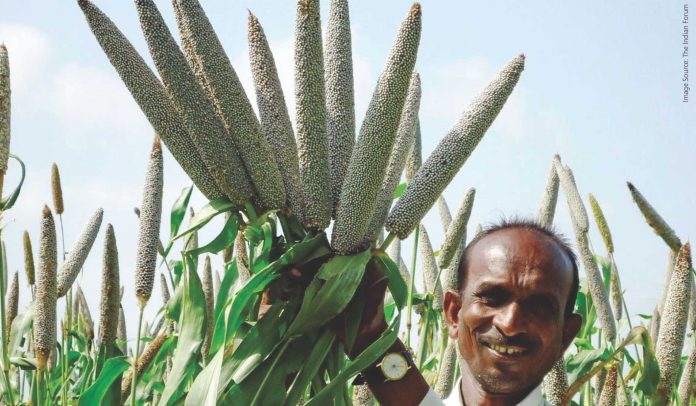

Millets are primarily grown as grain crops on marginal lands in dry areas of temperate, sub-tropical, and tropical regions of the world. For a long, these were generally considered inferior grains and were mostly consumed by the poorer sections of society in third-world countries. In fact, the nutritional qualities of millets were not fully known, which have remained the least exploited crops in the past. However, it is now well-known that millet farming could contribute to livelihoods, food availability as well as food security. In recent times, because of its nutritional profile, millets have assumed greater importance as food for humans as well as feed for animals. Given the current challenges regarding sustainable food production, climatic changes, and water scarcity, coupled with overpopulation, an interest has been developed regarding millets.
Another reason for the growing importance of shifting to the cultivation of millets is because of the frantic demand of maize, and its uses in multiple industries, which have merited the search for alternative grains, to erase the pressure.
Health benefits of millets
Millets are also believed to have nutraceutical health benefits for humans, and obviously for animals too. These benefits include an increase in digestive system well-being, a reduction in cholesterol, the prevention of heart diseases, protection against diabetes, the lowering of cancer risks, an increase in energy levels, and improvement of the muscular system
The diverse content of nutrients and phenolic compounds present in finger and pearl millet are good indicators. The phenolic properties found in millets comprisephenolic acids, flavonoids, antioxidants, and tannins. Moreover, finger millet has an exceptionally unique and more abundant, and diverse phenolic profile compared to pearl millet.
Millet-based foods are easily digestible by elders, infants, and those with gluten intolerance, due to their high content of probiotics and hypoallergenic nature of millets. The absence of gluten in millet is beneficial for individuals with irritable bowel movements. Due to higher fiber content, millets slow down digestion, thereby promoting efficient absorption of nutrients. The use of millet also reduces the cholesterol and TG levels in the body.
Millets are also rich in vitamins (Vitamin A, Vitamin B, Vitamin C), minerals (Calcium, phosphorus, potassium, and Iron), essential fatty acids, Bioactive phytochemicals including lignans, β-glucans, inulin, resistant starch, sterols, and phenolic compounds (e.g., ferulic acid, caffeic acid, and quercetin). Pearl millet contains higher energy compared to cereal grains, such as rice and wheat, and is considered a significant source of vitamins viz. thiamine, niacin, and riboflavin.
Inclusion in chicken diets
According to a recent study, including up to 50% whole pearl millet grain in the diet of broiler chickens does not negatively impact their performance. In fact, it has been found to significantly improve their growth and feed efficiency.
Research indicates that substituting up to 50% of corn in layers’ diets with sorghum has similar effects on egg production rates. Additionally, a study found that broilers’ body weight gain was not affected when millet replaced corn in their diets. Pearl millet varieties have also demonstrated comparable results to corn in terms of metabolizable energy and digestible amino acids.
Inclusion in ruminants’ diets
Millet grain viz. finger and pearl millets were evidently used to replace conventional grains, in the feed of small ruminants. An early study on lactating and growing goats found that feed intake and milk production were not affected by the replacement of corn with pearl millet. However, they recorded a depression in the daily growth rate and feed-to-gain ratio when corn was completely replaced with pearl millet.
Millet grain is also considered useful in the replacement of maize in big animals. A study done on cows observed that pearl millet grain could fully replace maize in high-supplement diets. Another study found that the processing of millet grain increases the digestibility of dry matter and dietary nutrients of grazing beef cattle during the dry season.
Ref: Hassan, Z. M., Sabola, N. A and Mabelabele, M. (2021). The Nutritional use of millet grain for food and feed. Agric. Food Secur.2021.
By Dr T. K. Walli, Former Head, Dairy Nutrition Division, N.D.R.I.













